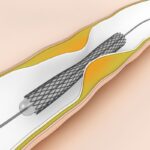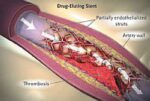Original title: Complete Versus Culprit-Only Revascularization for Patients with Multi-Vessel Disease Undergoing Primary Percutaneous Coronary Intervention for ST-Segment Elevation Myocardial Infarction: A Systematic Review and Meta-analysis. Reference: Kevin R et al. American Heart Journal, article in press. Primary angioplasty is the preferred reperfusion strategy in patients experiencing a STEMI as it has proven superior to fibrinolysis in reducing...
Noncardiac surgery is safe after 6 months after implantation of a DES
Original title: Risk of major adverse cardiac events following noncardiac surgery in patients with coronary stents. Reference: Hawn MT et al. JAMA 2013;DOI:10.1001 In the patients who underwent non cardiac surgery and had coronary angioplasty with stent history within 2 years there was not increased in major cardiac events (MACE ) with the exception of those who were...
Everolimus Eluting Stent in multiple vessels with short SYNTAX score
Original title: A Clinical and Angiographic Study of the XIENCE V Everolimus-Eluting Coronary Stent System in the Treatment of Patients With Multivessel Coronary Artery Disease. The EXECUTIVE (EXecutive RCT: Evaluating XIENCE V in a Multi Vessel Disease) Trial. Reference: Flavio Ribichini et al. J Am Coll Cardiol Intv 2013. Article in press. Drug-eluting stents (DES ) have emerged...
Stent Thrombosis in the Real World
Original title: Incidence and predictors of stent trombosis: a single-centre study of 5833 consecutive patients undergoing coronary artery stenting Reference: Javaid Iqbal et al. EuroInterventional 2013;9:62-69 Though potentially fatal, stent thrombosis is a low frequency event associated to stent malapposition, fractures, resistance to antiplatelet therapies, and diseases such as diabetes and kidney disease, among other factors. 5883 pacients...
Aortic Valvuloplasty in the transcatheter aortic valve implantation era
Original title: Emerging indications, in-hospital and long-term outcome of balloon aortic valvuloplasty in the transcatheter aortic valve implantation era. Reference: Francesco Saia et al. EuroIntervention 2013;8:1388-1397 Until a few years ago, aortic valvuloplasty had been abandoned by many centers due to its limited results and frequent complications. The current guidelines recommend aortic valvuloplasty to treat patients with symptomatic...
Hybrid revascularization, combining strengths in high-risk patients
Original title: One-Stop Hybrid Coronary Revascularization versus Coronary Artery Bypass Graft and Percutaneous Coronary Intervention for the Treatment of Multivessel Coronary Artery Disease: Three-Year Follow-up Results from A Single Institution. Reference: Liuzhong Shen et al. J Am Coll Cardiol Intv 2013. Article in press. Accepted Manuscript. A mammary bridge to anterior descending artery (LMCA) with a permeability >...
Incomplete revascularization: no longer a binary variable
Original title: Residual SYNTAX score after PCI for triple vessel coronary artery disease: quantifying the adverse effect of incomplete revascularisation. Reference: Christopher J. Malkin et al. EuroIntervention 2013;8:1286-1295. In the angioplasty branch of the SYNTAX study, complete revascularization was reached in 56.7% of the population. On the other hand, in the real world, around 40% of patients that...
Women have a higher mortality rate in ST-segment elevation acute myocardial infarction
Original title: Is the difference in outcome between men and women treated by primary percutaneous coronary intervention age dependent?: Gender difference in STMI stratified on age Reference: Amber M Otten et, al.European Heart Journal Acute Cardiovascular Care January 31:1-8 Numerous publications have shown that women have worse outcomes than men in chronic ischemic heart disease but their evolution...
Revascularization could improve areas traditionally considered necrotic
Original title: Prevalence of Regional Myocardial Thinning and Relationship With Myocardial Scarring in Patients With Coronary Artery Disease. Reference: Dipan J. Shah et al. JAMA. 2013;309(9):909-918 Regional left ventricular (LV) wall thinning is believed to represent chronic myocardial infarction. In fact, the most recent guidelines, both European and American, have concluded that “Images that show regional myocardial thinning...
Complete revascularization in one procedure is more cost effective and as safe as in stages.
Original title: Staged Versus One-time Complete Revascularization With Percutaneous Coronary Intervention for Multivessel Coronary Artery Disease Patients Without ST-Elevation Myocardial Infarction. Reference: Edward L. Hannan et al. Circ Cardiovasc Interv 2013;6;12-20. There is evidence that in patients with multi-vessel disease affected by an acute coronary syndrome (ACS) with ST segment elevation, only the cause lesion should be treated...









